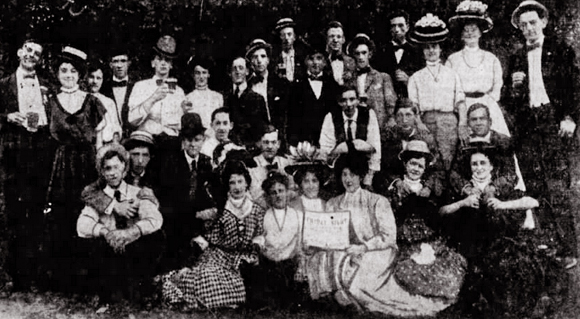There were many picnic parks in our area at the turn of the 20th century, but the most infamous of them was Mariendale Park. The park was located in Maspeth on 72nd Street and stretched between 52nd and Grand Avenues. Newspapers of the time are full of stories of assaults, drunken behavior and even murder.
Carl C. Ahrens opened the place around 1900 hoping to provide patrons with a good time. The picnic grounds and a dance hall certainly did that. The Maspeth Athletic Club opened on site October 14, 1908 with a boxing match that packed the house. Several prize fights were staged there over the years.
Ahrens’ Mariendale Park also hosted a large political event in 1914. The Bull Moose, known as the “progressives” of the time, held an outing there July 19 which drew about 1,000 people and ran from about noon to just before midnight.
The Park provided event space for many local organizations and clubs over the decades as well as Manhattan and Brooklyn groups looking to escape to the country for a few hours. Most people who attended enjoyed their time there and returned home safely. But there was also a seedy element to Mariendale Park.
Below are some of the sordid incidents attached to this location:
Charlie Hinzman of Manhattan, age 6, disappeared from a picnic that he was attending with his parents on June 10, 1900. His body was not found until 3 days later, face down in an old cistern only 10 feet from where he had disappeared. His father looked in the hole shortly after he went missing but reported seeing nothing. It was determined that the child had drowned.
Walter Wright of Brooklyn, 18 years old, was arrested for carrying a concealed weapon August 23, 1905. Twenty-two year old William Dolan of Bushwick was shot in the back by an unknown assailant as he was approaching the dance hall on June 28th, 1908. He was taken to the German Hospital where he later died. Charles Wagner of Maspeth was eventually charged with murder, but at his trial, the judge dismissed the charges, calling the main witness against him “a monumental liar”.
April 24, 1909 was the night that 14-year old Nina Knight disappeared after she arranged to meet 18-year old Frank Murphy of Brooklyn at Mariendale Park. They tried to elope but were caught in Brooklyn after a few days. Murphy was arrested for kidnapping and rape.
A little more than 3 months later, on July 25, 1909, 26-year old Manhattanite Jacob Silberman was assaulted and landed at St. John’s Hospital, then located in Hunters Point.
Joseph Kelly of Manhattan “flourished a revolver and acted in a disorderly manner” August 2, 1911.
On April 1, 1912, 29-year old Dominick Beratto of Corona was shot to death on Hillside Avenue due to his involvement in a love triangle. He apparently had taken both of his trysts to Mariendale Park where they found out about each other.
While attending a picnic on July 4, 1912, 17-year old Lillian Kiel of Maspeth noticed that her gold bracelet had been stolen and believed that it had been lifted by her then-boyfriend, 22-year old John Tugman of Brooklyn. Police picked him up in September but he denied the theft and due to lack of witnesses was released.
Sarah Holland, 17 years old, of Brooklyn, was shot by a jealous suitor for dancing with other boys on July 26, 1914. Her assailant’s name was Antonio DeGiregere, who went by the street name “Tony Toots.” He was also from Brooklyn. Sarah having never recovered, died August 5, 1914 at St. John’s Hospital and Antonio was charged with murder.
On May 26, 1915, 22-year old Frank Meereno of Brooklyn was shot on the streets of Maspeth by Edward Duffey of Maspeth after a quarrel over a girl at Mariendale Park picnic.
If this place had been around today, our civic association would most likely be calling for its closure. And, in fact, the Maspeth Civic and Improvement Association had complained about it for years – but not that the Park was a haven for crime. Their issue was that the dance hall sat in the path of 72nd Street and prevented its completion.
Owner Carl Ahrens lived with his family in a house on the property. He passed away in 1926, but had signed over control of the business to his son-in-law, Walter Bowden, a philanthropist and stage producer, about a decade prior. Picnic parks had been on the decline since America had entered WWI and then later suffered during Prohibition and the Depression. No one had money to rent a hall and no one wanted to party without booze. By the end of the 1920s, the attached outdoor pavilion was demolished and the dance hall was being rented by a wire manufacturing company. Over the course of the 1920s the owners began to subdivide the blocks-long lot and were selling off parcels to housing developers. From 1929-1931, the dance hall building sat vacant.
The Mariendale Park dance hall burned down in a spectacular fire March 21, 1931. The fire was so intense that it spread to nearby homes and left about 100 people temporarily homeless. Luckily, none of the occupants were killed. As reported in the Brooklyn Eagle, “Flames could be seen 10 miles away.” The fire was at first rumored to have been started by “tramps” that slept inside the hall and threw cigarette butts on its floor, but investigators disbelieved this theory, as the place had been observed sealed up tight prior to the inferno. It was estimated that the damage to the dance hall cost more than $100,000, which was covered by insurance. Fundraising was undertaken to assist adjacent homeowners that had lost everything and sympathetic neighbors took in those without a place to stay.
Prohibition was repealed in 1933, but Mariendale Park never rose from the ashes. The City was finally able to complete the construction of 72nd Street and the entire property was developed over subsequent decades, erasing all traces of what once was there.




